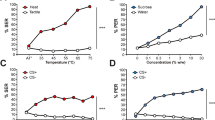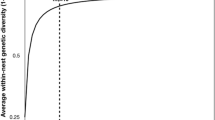Abstract
There has now been an abundance of research conducted to explore genetic bases that underlie learning performance in the honey bee (Apis mellifera). This work has progressed to the point where studies now seek to relate genetic traits that underlie learning ability to learning in field-based foraging problems faced by workers. Accordingly, the focus of our research is to explore the correlation between laboratory-based performance using an established learning paradigm and field-based foraging behavior. To evaluate learning ability, selected lines were established by evaluating queens and drones in a proboscis extension reflex (PER) conditioning procedure to measure learning in a laboratory paradigm—latent inhibition (LI). Hybrid queens were then produced from our lines selected for high and low levels of LI and inseminated with semen from many drones chosen at random. The genetically diverse worker progeny were then evaluated for expression of LI and for preference of pollen and/or nectar during foraging. Foragers from several different queens, and which had resulted from fertilization by any of several different drone fathers, were collected as they returned from foraging flights and analyzed for pollen and nectar contents. They were subsequently evaluated for expression of LI. Our research revealed that pollen foragers exhibited stronger learning, both in the presence (excitatory conditioning) and absence (LI) of reinforcement. The heightened overall learning ability demonstrated by pollen foragers suggests that pollen foragers are in general more sensitive to a large number of environmental stimuli. This mechanism could contribute toward explanations of colony-level regulation of foraging patterns among workers.



Similar content being viewed by others
References
Benatar ST, Cobey S, Smith BH (1995) Selection on haploid genotype for discrimination learning performance: Correlation between drone honey bees (Apis mellifera) and their worker progeny (Hymenoptera: Apidae). J Insect Behav 8:637–652
Bhagavan S, Benatar ST, Cobey S, Smith BH (1994) Effect of genotype but not of age or caste on olfactory learning performance in the honey bee, Apis mellifera. Anim Behav 48:1357–1369
Bitterman ME, Menzel R., Fietz A, Schafer S (1983) Classical conditioning of proboscis extension in honeybees, Apis mellifera. J Comp Psych 97:107–119
Brandes C, Menzel R (1990) Common Mechanisms in proboscis extension conditioning and visual learning revealed by genetic selection in honey bees (Apis mellifera capensis). J Comp Physiol A 166:545–552
Chandra BC, Hosler JS, Smith BH (2000) Heritable variation for latent inhibition and its correlation with reversal learning in honeybees (Apis mellifera). J Comp Psych 114:86–97
Chandra BC, Hunt GJ, Cobey S, Smith BH (2001) Quantitative trait loci associated with reversal learning and latent inhibition in honeybees (Apis mellifera). Behav Gen 31:275–285
Dyer FC (1991) Bees acquire route-based memories but not cognitive maps in a familiar landscape. Anim Behav 4:239–246
Eckert CD, Winston ML, Ydenberg RC (1994) The relationship between population size, amount of brood, and individual foraging behaviour in the honey bee, Apis mellifera L. Oecologia 97:248–255
Falconer DS, Mackay TFC (1996) Introduction to quantitative genetics, 4th edn. Addison Wesley Longman, London
Ferguson HJ, Cobey S, Smith BH (2001) Sensitivity to a change in reward is heritable in the honeybee, Apis mellifera. Anim Behav 61:527–534
Gary NE, Lorenzen K (1976) A method for collecting the honey sac contents from honeybess. J Apic Res 15:73–79
Gould JL (1986) Pattern learning by honey bees. Anim Behav 34:990–997
Greenspan RJ (2001) The flexible genome. Nature Rev Genet 2:383–387
Hellmich RL, Kulincevic JM, Rothenbuhler WC (1985) Selection for high and low pollen-hoarding honey bees. J Hered 76:155–158
Kevan PG (1987) Texture sensitivity in the life of honeybees. In: Menzel R, Mercer A (eds.) Neurobiology and behavior of honeybees. Springer, Berlin Heidelberg New York, pp 96–101
Laidlaw HH, Page RE (1997) Queen rearing and bee breeding. Wicwas, Cheshire, Conn.
Mackensen O, Nye WP, (1966) Selecting and breeding honey bees for the collecting of alfalfa pollen. J Apic Res 5:79–86
Menzel R (1990) Learning, memory, and “cognition” honey bees. In: Kesner RP, Olten DS (eds) Neurobiology of comparative cognition. Erlbaum, Hillsdale, N.J., pp 237–292
Oster GF, Wilson EO, (1978) Social insects. Princeton University Press, Princeton, N.J.
Page RE (1986) Sperm utilization in social insects. Annu Rev Entomol 31:297–320
Page RE, Fondrk MK (1995) The effects of colony-level selection on the social organization of honey bee (Apis mellifera L.): colony-level components of pollen hoarding. Behav Ecol Sociobiol 36:135–144
Page RE, Laidlaw HH (1982) Closed population honey bee breeding. I. Population genetics of sex determination. J Apic Res. 21:30–37
Page RE, Robinson GE, (1991) The genetics of division of labor in honey bee colonies. In: Evans PD (ed) Advances in insect physiology, vol 23. Academic Press, London, pp 117–169
Page RE, Robinson GE, Fondrk MK, Nasr ME (1995a) Effects of genotypic diversity on honey bee colony development and behavior (Apis mellifera L.). Behav Ecol Sociobiol 36:387–396
Page RE, Waddington KE, Hunt GJ, Fondrk MK (1995b) Genetic determinants of honey bee foraging behaviour. Anim Behav 50:1617–1625
Page RE, Erber J, Fondrk MK (1998) The effect of genotype on the response thresholds to sucrose and foraging of honey bees (Apis mellifera L.). J Comp Physiol 182:489–500
Pankiw T, Page RE (1999) The effect of genotype, age, sex, and caste on response thresholds to sucrose and foraging behavior of honey bees (Apis mellifera L). J Comp Physiol 185:207–213.
Rescorla RA (1988) Behavioral studies of Pavlovian conditioning. Annu Rev Neurosci 11:329–352
Rothenbuhler WC, Kulincevic JM, Thompson VC (1979) Successful selection of honeybees for fast and slow hoarding of sugar syrup in the laboratory. J Apic Res 18:272–278
Seeley TD (1985) Honeybee ecology. Princeton University Press, Princeton, N.J.
Scheiner R, Page RE, Erber J (2001a) Responsiveness to sucrose affects tactile and olfactory learning in honey bees of two genetic strains. Behav Brain Res 120:67–73
Scheiner R, Page RE, Erber J (2001b) The effects of genotype, foraging role, and sucrose responsiveness on the tactile learning performance of honey bees (Apis mellifera L.). Neurobiol Learn Mem 76:138–150
Schmid-Hempel P, Kacelnik A, Houston AI, (1985) Honeybees maximize efficiency by not filling their crop. Behav Ecol Sociobiol 17:61–66
Shafir S, Waite TA, Smith BH, (2002) Context dependent violations of rational choice in honeybees (Apis mellifera) and gray jays (Perisoreus canadensis). Behav Ecol Sociobiol 51:180–187
Von Frisch K (1967) The dance language and orientation of honey bees. Harvard University Press, Cambridge, Mass.
Winston ML, (1987) The biology of the honey bee. Harvard University Press, Cambridge, Mass.
Acknowledgements
This work was supported by NIH Grant 9 RO1 RR14166 to B.H.S. from NCRR. The authors wish to thank Susan Cobey and Sathees Chandra for assistance in aspects of fieldwork and laboratory analyses. The described experiments comply with current guidelines and regulations concerning subject handling.
Author information
Authors and Affiliations
Corresponding author
Additional information
Communicated by R. Page
Rights and permissions
About this article
Cite this article
Latshaw, J.S., Smith, B.H. Heritable variation in learning performance affects foraging preferences in the honey bee (Apis mellifera). Behav Ecol Sociobiol 58, 200–207 (2005). https://doi.org/10.1007/s00265-004-0904-4
Received:
Revised:
Accepted:
Published:
Issue Date:
DOI: https://doi.org/10.1007/s00265-004-0904-4




